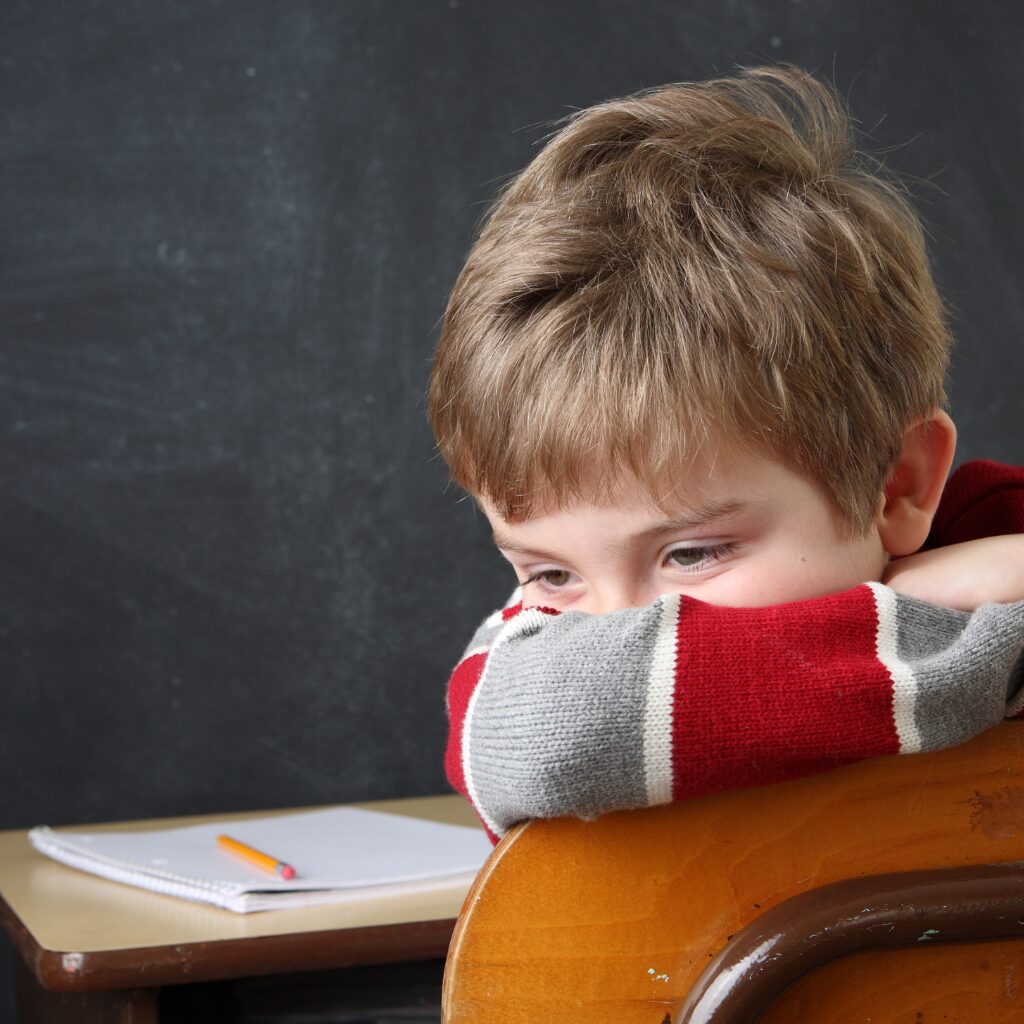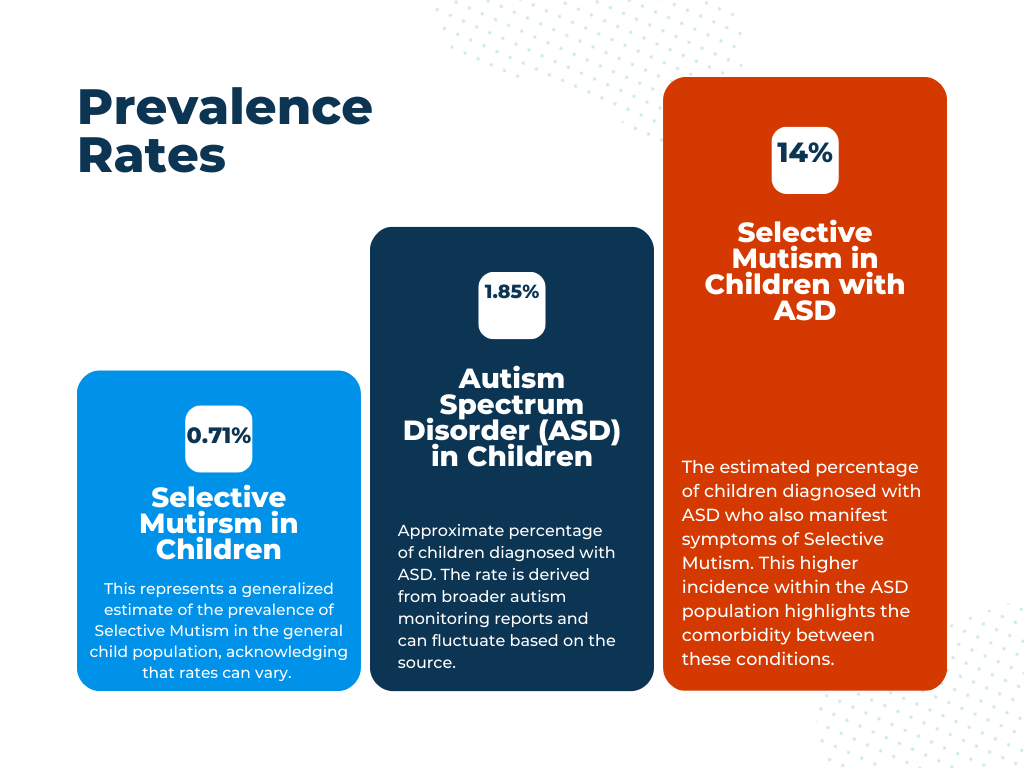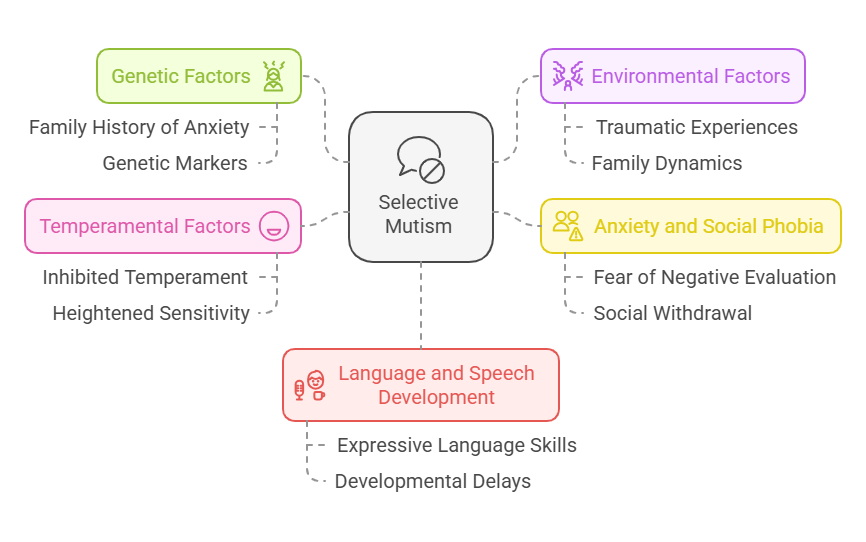
Introduction: When Selective Mutism and Autism Intersect
If your autistic child goes silent in certain situations, it can be confusing and worrisome. Selective Mutism (SM) is an anxiety disorder that makes speaking incredibly difficult in specific social settings. While SM can occur independently, there’s a significant overlap between SM and autism spectrum disorder (ASD).
Understanding this connection is crucial for parents of autistic children. With the right diagnosis, treatment, and support, children with SM and autism can learn to manage anxiety and find their voices. In this guide, we’ll delve deeper into what SM is, its connection to autism, how it’s diagnosed, and strategies for offering the best help to your child.
What Is Selective Mutism (SM) and How Does It Differ from Mutism?
Mutism vs. Selective Mutism: Understanding the Basics
The term “mutism” refers to a complete inability to speak. This can stem from various causes, including physical conditions, brain damage, or severe speech disorders. Selective Mutism (SM), on the other hand, is a psychological condition where a child has the ability to speak but finds themselves unable to do so in specific situations due to overwhelming anxiety.

When Does Selective Mutism Manifest in Children?
Children with SM might be lively and talkative at home with family but become completely silent at school, around unfamiliar people, or in new environments. They might communicate through whispers, gestures, nods, or writing, but find spoken words impossible to produce. It’s essential to remember that SM is not a choice or a form of defiance, but a genuine inability caused by a “freeze” response triggered by anxiety.
Examples:
- A child with SM may chatter freely with their parents but be unable to answer a question in class.
- They might play animatedly with a sibling but become nonverbal during a playdate with unfamiliar children.
Diagnosing Selective Mutism: Essential Guidelines and DSM-5 Criteria
To diagnose Selective Mutism, certain criteria must be met. The Diagnostic and Statistical Manual of Mental Disorders (DSM-5) provides specific guidelines for identifying this condition.
- Consistent failure to speak in specific social situations despite speaking freely in others
- This difficulty must interfere with school, social activities, or daily life
- The duration of symptoms should be at least one month (excluding the first month of school when adjustment can be expected)
- The lack of speech is not due to a lack of knowledge or comfort with the language spoken
- The disturbance cannot be better explained by another condition like ASD, a speech disorder, or severe social anxiety
In addition to meeting the diagnostic criteria, healthcare professionals evaluate several factors when diagnosing Selective Mutism, including:
- Severity of Symptoms: The degree to which the child’s Selective Mutism affects their daily life, social interactions, and academic performance.
- Contextual Factors: An assessment of the social situations in which the child exhibits mutism and the level of anxiety associated with these contexts.
- Comorbidity: The presence of any other co-occurring conditions, such as anxiety disorders, speech and language disorders, or Autism Spectrum Disorder.
Proper diagnosis is essential to develop an appropriate treatment plan and address the specific needs of children with Selective Mutism, considering the potential overlap with social anxiety disorder and autism spectrum disorder.
Prevalence
Selective mutism is relatively uncommon, affecting about 1% of children. It tends to emerge in early childhood, often around the ages of 3-5. Girls are slightly more likely to be diagnosed with SM than boys.
Data are illustrative and based on generalized estimates. For current and specific prevalence rates, consult the CDC, Autism Speaks, and the Selective Mutism Association.
Understanding the Causes of Selective Mutism: Anxiety, Genetics, and Environmental Factors
Selective Mutism is believed to have multiple contributing factors. It is considered primarily an anxiety disorder, often influenced by a combination of genetic, environmental, and psychological factors. While the exact cause of Selective Mutism remains unknown, research suggests a link between excessive shyness, an inhibited temperament, and an overactive amygdala, which plays a role in processing fear and anxiety.
Some potential causes and contributing factors of Selective Mutism include:
- Genetic Factors: Research indicates that Selective Mutism may have a genetic component, as it tends to occur more frequently in families with a history of anxiety disorders or shyness. However, specific genetic markers or mutations have yet to be identified.
- Environmental Factors: Traumatic experiences, family dynamics, and adverse social interactions can contribute to the development of Selective Mutism. Stressful life events, such as moving to a new school or experiencing family disruptions, may trigger or exacerbate symptoms.
- Anxiety and Social Phobia: Selective Mutism often coexists with social anxiety disorder or social phobia. Children with Selective Mutism may have an intense fear of negative evaluation, causing them to avoid speaking in certain situations to prevent embarrassment or judgment.
- Temperamental Factors: Children with an inhibited temperament, characterized by shyness, social withdrawal, and heightened sensitivity to new situations, may be more prone to developing Selective Mutism.
- Language and Speech Development: Some children with Selective Mutism may have experienced delays in their language and speech development. Difficulties in expressive language skills can contribute to their anxiety and make it more challenging for them to speak in certain social contexts.

It is important to understand that Selective Mutism is a complex condition influenced by a combination of factors. However, each child’s experience is unique, and the specific causes may vary from case to case.
Anxiety at the Root
Selective mutism is fundamentally rooted in anxiety disorders. Children with SM experience intense social anxiety that makes them feel paralyzed and unable to speak. This fear response can be so overwhelming that verbal communication becomes temporarily impossible.
Data source: Selective Mutism Association and Autism Speaks. Note: Percentages are illustrative and based on generalized data from these organizations on common social interaction challenges faced by children with Selective Mutism and ASD.
The Relationship Between Selective Mutism and Autism: Overlap and Differences
Research has indicated a significant association between Selective Mutism and Autism. Studies have shown that a considerable number of children with Autism also exhibit symptoms of Selective Mutism. However, it is important to differentiate between the two conditions, as they have distinctive characteristics. While Autism involves challenges in social interaction, communication, and repetitive behaviors, Selective Mutism primarily affects expressive language in certain social contexts.

The relationship between Selective Mutism and Autism can be complex and multifaceted. Here are some important points to consider:
Overlap of Symptoms: Both Selective Mutism and Autism share certain symptoms, such as social anxiety, difficulties in communication, and challenges in social interactions. However, it is crucial to note that not all children with Autism have Selective Mutism, and not all children with Selective Mutism have Autism. It is possible for a child to have both conditions simultaneously, but they can also occur independently.
- Differentiating Factors: While children with Selective Mutism typically exhibit normal social interactions and communication skills in familiar and comfortable environments, children with Autism may struggle with social communication and interaction in various settings. Additionally, Autism involves a broader range of symptoms and challenges beyond the scope of Selective Mutism.
- Co-Occurrence of Selective Mutism and Its Relations to Social Anxiety Disorder and Autism Spectrum Disorder: Research suggests that the co-occurrence of Autism and Selective Mutism may be related to shared underlying factors, such as anxiety disorders and difficulties in social communication. However, more research is needed to better understand the intricate relationship between these conditions.
Individualized Approach: When working with children who have both Autism and Selective Mutism, it is crucial to take an individualized approach that addresses the specific needs and challenges of each child. Tailoring interventions to target both Autism-related difficulties and Selective Mutism symptoms can provide comprehensive support.
It is essential for healthcare professionals, educators, and parents to be aware of the potential co-occurrence of Selective Mutism and Autism, as this knowledge can guide appropriate interventions and support strategies for these children.
Effective Treatment Strategies for Selective Mutism and Autism Support
Early intervention and appropriate treatment are crucial for children with Selective Mutism. Various approaches can be effective in addressing this condition, including behavioral interventions, cognitive-behavioral therapy (CBT), and speech-language therapy. Here are some key treatment considerations:
- Behavioral Interventions: Behavioral interventions, such as systematic desensitization and exposure therapy, are commonly used to help children with Selective Mutism gradually overcome their anxiety and increase their comfort levels in speaking situations. These interventions involve systematically exposing the child to progressively more challenging speaking tasks while providing support and encouragement.
- Cognitive-Behavioral Therapy (CBT): CBT focuses on identifying and modifying negative thought patterns and behaviors associated with anxiety. It aims to equip children with coping strategies, relaxation techniques, and problem-solving skills to manage their anxiety and facilitate speaking in challenging situations.
- Speech-Language Therapy: Speech-language pathologists (SLPs) play a crucial role in the treatment of Selective Mutism. They can provide strategies to improve speech production, enhance communication skills, and address any underlying speech and language difficulties that may contribute to the child’s mutism.
- Collaborative Approach: Collaboration between parents, educators, therapists, and healthcare professionals is essential in developing a comprehensive treatment plan for children with Selective Mutism. Regular communication and coordinated efforts ensure consistency across different settings and provide a supportive network for the child.
- Medication: In some cases, medication may be considered to manage anxiety symptoms associated with Selective Mutism. Medication options may include selective serotonin reuptake inhibitors (SSRIs) or other anxiety-reducing medications. It is important to consult with a healthcare professional for a proper evaluation and guidance regarding medication use.
Additional Strategies for Promoting School Inclusion and Peer Support
It is important to recognize that Selective Mutism is a complex condition, and each child’s needs may vary. Tailoring the treatment approach to the specific challenges and strengths of the child is crucial for successful intervention.
- Parent and Educator Involvement: The involvement of parents and educators is integral to the success of treatment for Selective Mutism. They can provide support, reinforce positive behaviors, and collaborate with professionals to create a consistent and supportive environment for the child. Psychoeducation for parents and teachers can also help them better understand Selective Mutism and implement strategies to facilitate the child’s progress.
- Peer Interaction Interventions: Peer interaction interventions can be beneficial for children with Selective Mutism. Encouraging interactions with supportive peers in structured settings, such as in social skills groups or cooperative activities, can help the child build confidence and practice communication skills.
- Gradual Exposure and In-Vivo Practice: Gradual exposure and in-vivo practice involve gradually exposing the child to anxiety-provoking situations and providing support to help them build confidence and gradually increase their speaking behaviors. This approach helps children develop coping strategies and overcome their fear and anxiety in real-life settings.
It is crucial to have a comprehensive treatment plan that addresses the specific needs of the child with Selective Mutism. Treatment should be individualized, tailored to the child’s unique challenges and strengths, and adjusted based on their progress and comfort levels.
 Conclusion: Empowering Children with Selective Mutism and Autism through Inclusion and Support
Conclusion: Empowering Children with Selective Mutism and Autism through Inclusion and Support
Understanding the connection between Selective Mutism and Autism is essential in providing appropriate support and interventions for children with these co-occurring conditions. Recognizing the distinctive features of Selective Mutism, including the inability to speak in specific social situations despite having the capacity for verbal communication, can guide effective treatment strategies.
Early intervention, involving a collaborative approach between parents, educators, therapists, and healthcare professionals, plays a vital role in helping children with Selective Mutism. Tailored treatment plans, combining behavioral interventions, speech-language therapy, and cognitive-behavioral therapy, can empower children to overcome their challenges and develop effective communication skills.
By fostering a supportive and inclusive environment, promoting understanding and awareness, and implementing evidence-based interventions, we can provide children with Selective Mutism and Autism the tools they need to thrive and reach their full potential.
For additional information and resources on Selective Mutism and Autism, please visit the following reputable sources:
Remember, early identification and intervention are key to supporting children with Selective Mutism and Autism. With the right support and understanding, we can help these children navigate social situations and communicate effectively, enabling them to lead fulfilling lives.

 Conclusion: Empowering Children with Selective Mutism and Autism through Inclusion and Support
Conclusion: Empowering Children with Selective Mutism and Autism through Inclusion and Support
